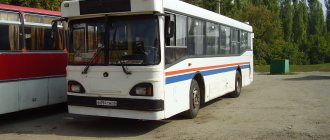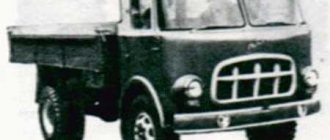For other meanings of ESD, see ESD (meanings).
Pavlovsk Bus Plant
| Chimney of the Pavlovsk bus plant | |
| Type | Public company |
| Trades as | MCX: PAZA |
| Industry | Automotive industry, ISIC: 2910 |
| Based | 1932 (1932) |
| Headquarters | Pavlovo, Nizhny Novgorod region , Russia |
| Key people | Andrey Vladimirovich Vasiliev |
| Goods | buses |
| Income | $256 million[1] (2017) |
| Operating profit | $7.54 million[1] (2017) |
| Net income | $12.4 million USA[1] (2017) |
| Total assets | $339 million[1] (2017) |
| Total capital | $102 million[1] (2017) |
| Parent | Bus division of GAZ Group |
| Web site | www.paz-bus.RU |
Former brand of the company PAZ buses - the workhorses of public transport in Nizhny Novgorod
Pavlovsk Bus Plant
(Russian: Pavlovsky bus, formerly Pavlovsky bus plant,
Pavlovsky bus plant
or
PAZ
) is a manufacturer of buses in Russia, in the city of Pavlovo, Nizhny Novgorod region. PAZ is a subsidiary of Russian Buses which is a division of GAZ.
Pavlovsk Bus Plant specializes in the development and production of small and medium class buses (length 9.7 m). Buses are the most common plant in Russia, their annual production is more than 10 thousand units, which is almost 80% of small buses in Russia. Small PAZ buses have long been used by Russian “minibus taxis” ( marshrutka
) operators.
Starting in 2015, the GAZ Group introduced a single brand for all bus production subsidiaries, and a deer icon appeared on newly produced vehicles. GAZ Company.[2]
Story
The factory originates from the ZATI automobile and tractor tool plant, founded in Pavlovo in 1932.[3] Construction of the plant began in 1952, and in the same year the first long-hood PAZ-651 buses (based on the GAZ-51 general purpose truck) were produced. The government had a plan to produce 10,000 buses per year. In 1960, production began of a new model PAZ-652 with forward control on the same chassis. It was replaced by the outwardly similar PAZ-672 (a truck based on the GAZ-53) at the beginning of 1968, and this bus had a large family of different modifications. In 1989, production began of the new PAZ-3205 model, which has basically the same chassis, but a completely new body.
It's 90's time for Paz
Against the confusion of the national economic changes in a large country at that time, the emergence of the perestroika period and the collapse of the state, Pavlov’s designers and workers were able to specialize and master the production of a freshly baked modification of the PAZ-3205.
Mass production of this modification became the most numerous in the history of the plant. It continued for ten flights until 2000. More than 30 modifications were made based on this modification. They were given the opportunity to be used in a variety of geographical latitudes and for different needs. The model range includes luxury equipment and highly specialized options. Development and production of the main low-floor bus of a small class. This was a first for the Russian region. At the beginning of the new millennium, the production forces of the enterprise were radically expanded. We began developing buses of mediocre and large classes, as well as equipment created for international transportation. Noble competition prevented the company from gaining a foothold in the market of heavy-duty models. That is why the workers of Paz made do with producing a small number of equipment.
Models
Current
- PAZ-3205 (1989-present)
- PAZ-3206 (1995-present)
- PAZ-3237 “Meadow” (2002-present)
- PAZ-4234 (2003-present)
- PAZ-3203 (2006–present)
- PAZ-3204 (2006-present)
- PAZ Vector 4 (2012-present)
- PAZ Vector 3 (2015-present)
- GAZ Vector Next (2016-present)
Former
- PAZ-651 (1950-1961, based on GAZ-51I) PAZ-651A (1961-1971)
- PAZ-661B
Panel vans
- PAZ-657 (1954–1958, based on GAZ-51)
- PAZ-659
Trailers
- PAZ-658
- PAZ-740
- PAZ-742
- PAZ-743
- PAZ-744
- PAZ-746
- PAZ-750
Prototypes
- PAZ-665 (1964)
- PAZ-671 (1958, based on GAZ-52) PAZ-671A (1958, based on GAZ-53)
- PAZ-671G (based on GAZ-52A)
Modern automated process control systems
Hello! After reading an interesting article, I wanted to share my knowledge and thoughts about modern automated process control systems. What is described below applies to a greater extent to products from such companies as Yokogawa, Siemens and Honeywell. I want to say right away that each of the systems has its own characteristics, advantages and disadvantages, so I am describing only the general characteristics of modern automated process control systems. Modern automated process control systems ( APCS
), used in hazardous industries and enterprises (chemical, petrochemical industries, hydroelectric power plants, thermal power plants, nuclear power plants, etc.), as a rule, consist of a distributed control system (
DCS
) and an emergency automatic protection system (
EPS
).
RSU
The DCS is a software and hardware complex consisting of the following elements:
- Instrumentation and automation (instrumentation and automation) – equipment with the help of which direct observation and control of technological processes is carried out. All kinds of valves, cut-off valves, electric valves, pressure, temperature, level sensors, gas analyzers, pumps, vacuum hoods and many other devices belong to instrumentation and automation. By type, signals from instrumentation and control systems can be analog (4-20mA, 0-5V, etc.) and discrete.
- The programmable logic controller (PLC) is the heart of the automated process control system and consists of duplicated power supplies, duplicated processor modules and input-output modules. Sensors and control equipment from the field are directly connected to the I/O modules. The processor modules are loaded with automatic control and safety interlocking logic.
- A human-machine interface (HMI) is usually a personal computer with Windows OS (2000/XP) installed on it and specific software used to configure the process control system. Such computers are usually divided into several types: operator station, engineer station, instrumentation engineer station. The engineer's station allows you to use specialized software to change the configuration and execution logic of the PLC. Operator stations are the workplace of technologists and the shift supervisor, which allows monitoring and regulation of the technological process. Operators may have different access rights; usually ordinary operators do not have access to equipment whose operation affects safety; the shift supervisor has the greatest authority (but still lower than that of an engineer). It should be understood that the PLC cannot be reprogrammed from the operator station. The instrumentation engineer station has more applied capabilities and provides monitoring and diagnostics of field equipment.
GROOVE
The main task of the ESD is to transfer production to a safe state if any problems arise in the operation of the DCS (technological processes go beyond the established boundaries, equipment failure, emergency situations). As a rule, the ESD system receives data from duplicate sensors (one of the most reliable schemes is “2oo3”, when the activation of any 2 of 3 sensors installed at one control point is considered a necessary condition for the safety interlock to operate) and controls redundant equipment. The ESD system does not have operator stations; there is only an engineering station, which is used to configure the PLC of the ESD system. From the DCS operator stations you can see how the safety system works, but you cannot control it. The final equipment does not depend on the DCS equipment; for example, if the DCS valve is jammed on the pipeline, then the safety cut-off system will operate.
Features of automated process control system
Now I would like to note the important features of modern automated process control systems:
- If all operator stations fail, process control continues; if necessary, conditions can be added under which the failure of all stations causes a safe shutdown of production.
- Operator stations are connected to the production network, but as a rule, do not have access to the Internet, do not have the ability to connect USB storage devices, and do not have a disk drive. Also, often, operator stations do not have a standard computer keyboard, but are equipped with specialized keyboards equipped only with the necessary function keys.
- Engineer stations, as a rule, are completely turned off or are in sleep mode.
conclusions
Thus, the operator’s station is unlikely to be infected with a virus, but even if this happened, it does not pose any obvious security threat.
Of course, there are cases when operators bypass the bans and manage to install games on their stations and access the Internet, but this is quickly stopped by deprivation of bonuses and other administrative methods. If we assume that there is a specialized virus that knows the peculiarities of the functioning of systems and can hypothetically control the technological process, thereby causing negative consequences, then in any case, if an emergency occurs, the emergency protection system (which is not controlled from operator stations) will work and transfer production in a safe condition. Yes, this will be millions of losses for the enterprise (production stoppage), but in any case it is not a man-made disaster. If we talk about the likelihood of a virus infecting a PAZ engineering station, then, firstly, it must be a super intelligent virus that itself reprograms the PLC, and precisely so that it fails at the right moment, and secondly, PAZ engineers must be completely brainless and dig a hole for yourself. Of course, these are not all the factors that make infection of an ESD engineer’s station an unlikely event; I can cite a few more: constant verification of the version of programs loaded into the PLC, constant monitoring of the room with engineering stations, and of course, the password set for the ESD system project itself. In the end, I would like to say that the security of modern automated process control systems is, of course, threatened by viruses and other high-tech problems, such as operator stations going into a banal BSOD, but they are not as critical as many want to imagine. We must remember that safety is monitored by ESD systems, the configuration of which is approached with the utmost care and responsibility. The human factor always takes place, but ESD systems are created to reduce the negative impact of this factor to a minimum.
I will be happy to answer questions if they arise.
UPD.
A possible scenario for an attack on a SCADA system was reasonably described by makran, to whom, by the way, thanks for the invite.
Good luck!
Gallery
- PAZ-672
- PAZ-672 Emergency gas service Command bus in Moscow
- PAZ-3205
- PAZ-3204
- PAZ-3237 in Moscow
- PAZ-4230 "Aurora" in Gatchina
- PAZ-4234
- Row of new PAZ school buses on the central square of Chisinau, Moldova
- Groove Vector 3 (right) and Vector 4 (left)
Buses for collective and private use
Since the mid-2000s, the Pavlovsk Aircraft Plant has been participating in a national project that provides transport for teenagers.
Today's chronicle of bus drivers is a new development of classic miniature vehicles of various modifications. State regalia and awards as a result of the properties and strength of the bus plant. The passage of a qualified workforce will show its results.
More interesting stuff here: Reviews.
The history of the creation of PAZ model buses in the USSR. What changes did this transport have and why did citizens praise it?
- Previous: Rating of the most popular cars for women
- Next: Rating of cars up to two million in 2022
In Vasmer Max's dictionary
genus. p. paza, ukr. groove - the same, other Russian. groove, slovenian ра̑z – the same, Czech, Polish. raz along with Slovenian. rȃž m. “plank wall” (from *pāzi̯os). Related to Greek. πήγνῡμι “drive, hammer in”, πῆγμα “frame, fastening”, πάγος cf. R. “frost, frost”, lat. rango, rerigi, rastum “to drive in, drive in”, compāgēs w. “joint, connection, connection”, Middle Irish. āge “member” (*рāgio-), d.-v.-s. fаh “fence, wall, compartment”, new-century-n. Fаch “department, industry”. Along with I.-e. *рā̆ĝ- represented by *рak̂- in Lat. rasīsсō, rasīsсor “conclude an agreement”, rastum “agreement”, Greek. πάσσαλος, att. πάτταλος “peg, wooden nail”, d.-v.-n. fâhan, fangan “to catch”, d.-v.-n. fuoga “groove, joint”; see Trautman, BSW 209; Matzenauer, LF 12, 326; Brandt, RFV 23, 290; Tsupica GG, 197; BB 25, 91; Uhlenbeck, RVV 22, 189; Walde–Hofm. 2, 231 et seq., 245 et seq.
In Dahl's dictionary
m. groove, groove; grooves: groove m. narrow and long hole, gap, joint, from the junction of the board to the board; a deep, continuous furrow, a groove dug into something for the entry of boards and hewn beams. The fence boards slide into the grooves of the posts. The groove along the coal edge is called. quarter. Caulk the grooves of the boat, hut. To groove, hollow out, hew out, remove grooves. Paged piles, sheet piles, where one fits with its longitudinal ridge into the groove of the other. | North scolding is smelly. Water-resistant piles are being grooved, they are being grooved. Grooving fish, plastering, cutting and gutting. Grooving freebies, glass melting. cut lengthwise and roll out a blown glass bubble, freebie, into a sheet. Groove bast, birch bark, chop, knock down from a tree, strip the bark lengthwise. To rip, to cut, to rip. Pull it out, take out the groove. Add, finish. Stock up, start. To spoil, to pile up a thing. Attack, prepare the page. Punch, start. To surround, to live”>to surround with a groove. To retreat or -sya, to finish. Hit a little. Put something under, make a groove under something. Re-groove again. Been gone all day. Spread out what, spread out. Pagenje Wed. groove about. valid according to verb. Grooved, grooved, related to grooves and pages. Pazilo cf. paznik m. a type of adze or pickaxe with which grooves are selected; | a wide, straight chisel on a pole, with which they groove and knock down rock, birch bark, Puzzler, groover, groover, m. whoever grooves, selects grooves or plaster. | Paznik, puzzler, scolder, plowman, foul-mouthed person. These Ryazan and Kursk residents are such idiots that our brother (northern or eastern peasant) cannot live with them. Paznya north foul language, profanity, swearing, swearing, swearing. Pazlonka astrakh. spread out beluga in brine. Paznogt m. sib. the last, extreme joint of the finger, or its tip, where the nail sits, post-nail; Poznok(g)ti, church. the same, the tip of the fingers, open nails or hooves (not ankles, Academy Dictionary). Every cattle has cloven hooves and has its nails in two, Leviticus XI, 3, that is, an animal whose last joints of the fingers are divided, forked, split. Pazanka hunting hare's foot, esp., hind, with deeply spread fingers. | Pazankas and pazdanki Sib. fingers and claws in the form of pendants, above the brushes of ungulates, for example. from an elk, from a pig. The elk bloodied his pussies by chicher. Pazanch, pazanch the hare, cut off the hind legs to the ankles. A sinus, a sinus, any recess, emptiness, a space that extends deep into something, a bag, an opening, a passage; Therefore: space between the chest and clothing, above the belt. Put the crust in your bosom, and in your bosom. Don't go into the bosom. only the breast knows, and the sinus does not know! secret. Not just the money that your uncle has, but the money that’s in your pocket (in your pocket). He warmed up the snake in his bosom, about ingratitude. Not a caress that would put burrs in your bosom. He lied so much that you can’t get it out of your bosom (you can’t climb over it). He won’t reach into his bosom for an answer. In the father-mother's bosom (in the parental home). He took his head off his shoulders and put it in his bosom, and that’s it (and it will be safe)! It’s like you’ll bury your head in your bosom! The man looks not with his mouth, but with his bosom. Make friends, be friends, and keep a knife (or a stone) in your bosom. I love my friend: bite the pie and get it in your pocket! Heads around, and in the bosom, that is, she stole it. The mother, hiding it for the children, broke through her sinus; and the children, hiding from their mother, broke through two. You yourself are naked, and your shirt is in your pocket? candle. | Axillary sinuses, armpits. | The very chest of a person, from the neck to the spoon, is also called the sinus, although the sinus is formed only by the clothes on the chest. The cerebral sinuses, two muscular voids, inside the brain. | architectural arch or overhang of masonry, curvature of a vault, sail of a vault. | Bay, backwater, bay. | A sinus in an ulcer, a hole, a purulent tract under the skin or between the muscles. | Bosom in the oven, hard. stove, hot pot, porsk, babka, baburka, stove, zagnetka, ash pit, little alley to the left of the pole, for raking in the heat. | There is space in the barn, space, air on both sides of the hut, in the floor, along the walls, where the heat from the pit passes through. A suitcase with pockets, with bags on the sides or in the lid. Axillary, related to the sinus. This is a retarded snake. Axillary, wide, free, spacious in the sinus. Sinus ulcer, with many sinuses. Pasushnik m. rough red tape. The wind blows the sails, inflates them with its bosom. (The sinus was given the main significance of the chest, but the connection with the groove was not indicated; and in Shimkevich, the sinus was taken as a root?).
Description and meaning of the logo
PAZ logo until 2014-2015. was a circle open at the bottom with a four-pointed geometric figure enclosed in it, reminiscent of a crown. The lower part of the sign is the name of the groove.
Since 2015, as a result of the restructuring of production and the company, new and restyled models have been produced under the control of GAZ. The PAZ emblem on them has been changed and represents a deer. The same animal is featured on the coat of arms of the Nizhny Novgorod region.
The sign also indicates belonging to the holding. The manufacturing company has not changed after the rebranding; the technologies remain the same. Innovations concerned a change of sign, certification, and stricter requirements for the final product.
The lineup
New models 3204 (2009) and 3205/06, 4234 (2015) can be found at dealers. Serial production was established for modifications 3010 (2005), 3201 (1972), 3237 and 32053 “School” (2002), “Real” and “Vector” (2007 and 2016, respectively).
Variations of the high-floor bus 3205 have acquired special significance throughout the world. More than 1,000 vehicles are sold every year. The car has become popular among employers organizing the transportation of workers, tourism organizations and public transport. Specifications:
The almost 100-year history of the PAZ brand and worldwide recognition allowed the plant to deservedly be called the main manufacturer of small and medium buses in Russia. The company is among the top 10 largest global suppliers in its segment. Today, the PAZ logo means a high-quality and safe car, which remains the most profitable option for passenger transportation.
Source
PAZ today
Today PAZ is part of the largest domestic automobile manufacturing holding, GAZ Group. The company has a Certificate of Compliance with the ISO 9001 quality management system for the development, production, warranty and service of buses.
The Pavlovsk bus plant is one of the few enterprises in the industry that almost fully utilizes its designed capacity and is among the top ten major global manufacturers in terms of production volume. The daily production rate of buses is 42 units.
The PAZ bus is the most popular Russian bus. The seven-meter PAZ-3205 bus was and remains the main production model of the plant. In 2009, the PAZ-3204 family was launched into mass production. Today, the share of buses of the PAZ-3204 family in the plant’s production plan is 20%.
Since 2003 The principles of the GAZ production system are being introduced at the plant. Thanks to the scientific methodology of organizing production, there is an effective mechanism for reducing costs, optimizing technological processes, and reducing costs.










